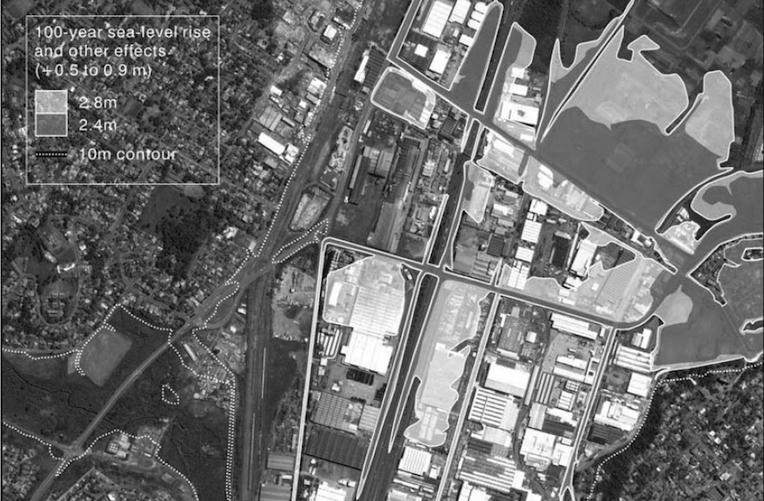 Source: Adapted from Environmental Management Department, EThekwini Municipality
Source: Adapted from Environmental Management Department, EThekwini Municipality
Durban, South Africa, is the largest port and city located on the east coast of Africa, with a population of approximately 3.7 million. The city covers a spatial area of 2,292 square kilometers and terrain ranges from flat coastal plain in the east to steep and undulating hills in the west. The city is characterized by a subtropical climate, is a biodiversity hotspot, and acknowledges significance of ecosystem services. Durban suffers from unemployment as 34% of working age residents are unemployed. Slums and poverty leave their mark on the makeup of the city as a result of apartheid policies.
A climate risk assessment (Mehrotra et al., 2009) shows that Durban faces a number of hazards caused by climate shifts in the region—the first being increasing temperatures, which can lead to problems with drought in the future. Rainfall events are expected in increase in intensity and decrease in duration, leading to problems of availability and flooding in the city. Sea level rise is another hazard, in isolation and in combination with the threat of storm surges from extreme weather events.
There is a disproportion of vulnerability due to infrastructure and zones at risk. The wealthy are affected by the vulnerability of the shoreline—a locus of economic activities like tourism—which faces increased vulnerability to erosion and inundation due to storm surge and general sea level rise. The poor are affected by the vulnerability of homes and infrastructure to sea level rise and flooding caused by intense rainfall events. Differential institutional responses are needed for poor and wealthy.
Resource and institutional constraints limit the adaptive capacity of Durban. The eThekwini Municipality is currently seeking to develop a climate change adaptation and mitigation strategy that balances environmental and developmental needs. Disaster Risk Reduction Offices were created in response to major climate change events. However, the effects of climate change on agriculture and water availability will aggravate the rural-urban migration, stressing Durban’s already limited resources. The Durban Adaptation Charter of 2011suggests there is a strong political will to provide leadership in Adaptation efforts reacting to climate change in the region.
Adaptation measures necessary to respond to climate risk in Durban should focus on the water sector. These include reducing vulnerability of informal settlements to flooding during extreme events with improved drainage and water management. Also, revising construction standards for key infrastructure and developing a shoreline management plan to defend the coastline and its infrastructure is recommended, including raising the height of shoreline stabilization measures. Durban focuses climate efforts on adaptation rather than mitigation, given the nature of their vulnerabilities and key hazards brought on by climate change. Durban is working on taking adaptation to all levels of long-term government planning. Mitigation efforts are aimed at reforestation and alternate energy sources, but mitigation is not the focus. Durban will have to work on re-locating communities in flood-prone areas to reduce vulnerability of informal settlements to severe climatic events.
Our first policy mechanism supports at-risk communities. First, re-zone areas vulnerable to sea level rise. The building code system will enforce sustainable and resilient constructions for the population at risk. Second, create a loan system to retrofit at risk buildings for those that need monetary assistance.
Our second policy mechanism is to develop collaboration between the eThekwini Environmental Planning Department and Durban’s Disaster Management Program, as well as hospitals, to assist with increased injury and poor health associated with climate change. Currently, Durban’s Disaster Management Program is reactive whereas we suggest it needs to become proactive.
Durban is a city at high risk of sea level rise. Adaptation measures will be difficult at local level because water services are typically provided by different agencies with different political drivers. The adaptation agenda should promote an integrated approach to climate mitigation and adaptation, working across sectors both public and private (ICLEI). . Urban management that takes into account sea level rise will be important in the following decades.
This article is a product of Professor Shagun Mehrotra’s Climate Change and Cities class. Views expressed are entirely those of the authors.
References
Arikan, Y., et.al. , ‘carbonn Cities Climate Registry 2011 Annual Report’, Bonn Center for Local Climate Action and Reporting– carbonn, Bonn, 2011.
Carmin, JoAnn, et al., “Planning Climate Resilient Cities: Early Lessons from Early Adapters,” 2009.
Durban Adaptation Charter. eThekwini Municipality. 2011. United Nations Framework Convention on Climate Change.
Conference of the Parties 17.
EThekwini Municipality Online Services.
http://www.durban.gov.za/Resource_Centre/Press_Releases/Pages/2012_2013Budget.aspx
Hounsome, R., Iyer, K., Naidu, S. “Climatic Future for Durban”. CSIR Environmentek. 2006.
ICLEI. Perspectives on Water and Climate Change Adaptation: Local government perspective on adapting water
management to climate change.
Mehrotra, S., C.E. Natenzon, A. Omojola, R. Folorunsho, J. Gilbride & C. Rosenzweig. (2009). Framework for city climate risk assessment. Washington, DC: World Bank.
National Weather Service page accessed 12/11/13, http://www.nws.noaa.gov/om/hurricane/resources/surge_intro.pdf
O’Donoghue, Sean. “Climate Change Policy and Integration in eThekwini Municipality, South Africa: Lessons from the
Durban CEBA and the Durban Adaptation Charter”. Environmental Planning and Climate Protection Department.
Roberts, Debra. “Prioritizing climate change adaptation and local level resilience in Durban, South Africa”. Environment and
Urbanization (22: 397), 2010.
Roberts, Debra. “Thinking globally, acting locally — institutionalizing climate change at the local government level in Durban,
South Africa”. Environment and Urbanization (20: 521), 2008.